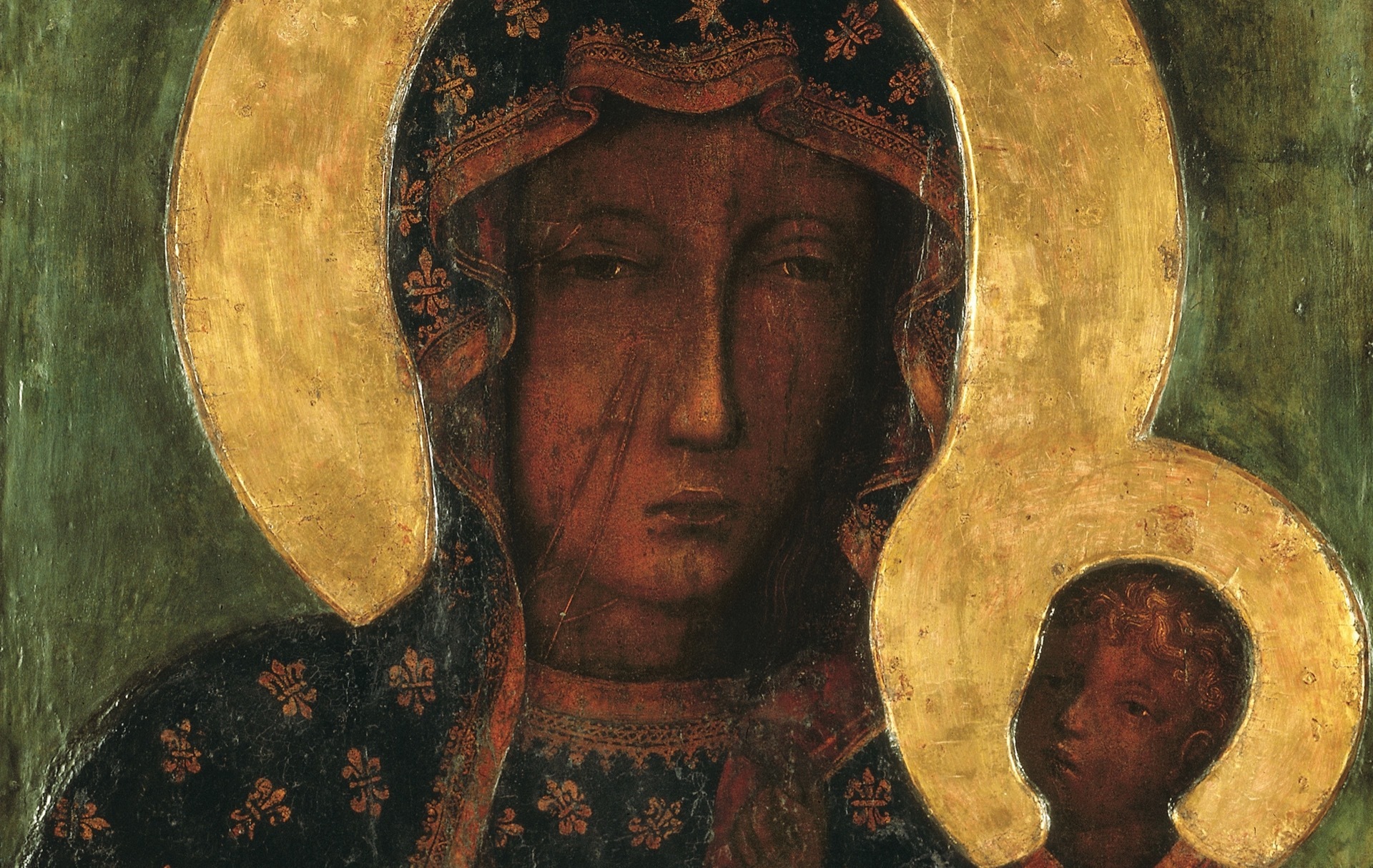This is translated from Polish that appeared on niedziela.pl and titled ‘Odkrywamy Jasną Górę (15) Jasnogórska Hodegetria’ written by Fr. Jan Stanislaw Rudzinski OSPPE.
The image of the Virgin Mary of Jasna Gora belongs to the so-called Hodegetria type, i.e. the Virgin Mary – Mother of God, an intercessor with the Son, interceding for humanity, and guide leading to Christ. According to the usual scheme for this type, Mary is depicted frontally, with her right hand folded on her breast and the Child Jesus on her left arm. Jesus, facing his Mother, raises his right hand in a gesture of blessing, while in his left hand, he holds a scroll or a Gospel book. Depending on the mutual positioning of the heads of Mary and Jesus, the arrangement of the Mother’s right hand and the position of the Infant’s feet, several variants of iconographic representations of Mary can be distinguished. The Byzantine icon from the end of the 10th century, found in the church of S. Maria Maggiore in Rome; the mosaic icon from the 12th century, preserved in the Serbian monastery of Chilandar on Mount Athos; and the image of Our Lady from the church of S. Maria Nuova in Rome can be considered the closest analogue of the Czestochowa Image.
The Jasna Gora painting is painted in tempera technique on canvas pasted on 3-3.5 cm thick linden boards glued together, measuring 120.2 x 81.6 cm, in a frame of 137 x 97.2 cm. The painting is made on glue and chalk mortar. The convex wooden border of the painting and the recess in the middle of the front side of the board were achieved by deepening the board’s surface. Both the paint, the mortar, the canvas and the panels have many different cavities and injuries, in which the image’s long and, at the same time, mysterious history is imprinted.
Our Lady is depicted frontally, with her head slightly turned to the left, towards the Infant. She is dressed in a dark blue gown and a red-lined cloak of the same colour, also encircling her head. The extraordinary impression is enhanced by the particular contrast between the majestic and hieratic positioning of the figure of the Mother of God and her delicate, girlish face and the strand of wavy hair flowing freely along her cheek. Mary’s drawn face is illuminated by light from above, slightly from the right, which models the narrow, elongated nose and small but prominent mouth. The left side of Mary’s face plunged into shadow, is clearly asymmetrical, adding even more life-like qualities to the face. The expressive power of the painting is concentrated in the eyes of the Mother of God. They look directly at the viewer from under lowered as if slightly puffy eyelids. Clear flashes of light shine around the irises on the inner side. Mary gazes with an expression of poignant, subtle sadness and reflective thoughtfulness.
On her right cheek, there are ‘scars’ indented into the texture of the painting and saturated with cinnabar. The two largest, almost parallel, crossed at the top by a transverse scratch, pass diagonally across the cheek from the middle of the nose to the neck and then up to the fold of the robe. Two smaller ‘scars’, also indented into the texture, are on the right side of the neck. Mary folds her right hand diagonally over her breast. On her left, through the hem of her cloak revealing only her fingertips, she holds the seated Child, whose head is turned slightly to the right, raised upwards and slightly tilted back. The Child is looking not at his Mother but straight ahead, directly at the beholder. The face of Jesus – round, with childlike charm (short nose, small but full lips, tiny curls) – is also imbued with a poignant sadness, concentrated in the expression of eyes looking out from under lowered eyelids. The Child is dressed in a tunic with a broad vertical fold at the neck and narrow, cuffed sleeves. The
robe is tightly wrapped around the bent legs so that only the toes of the left foot are
visible from under the robe. The Child’s relatively small head is in stark contrast to the large hands and toes. Jesus raises his right hand in blessing while his left-hand holds the Gospel codex horizontally. The colour scheme of the entire painting is dark and saturated. This colouration is intensified by the darkened layers of varnish. The complexion of the face of the Virgin and Child Jesus is a burnt ochre colour, turning to shades of red in the highlights, falling into a dark umber tone in the shadows.
A strand of wavy hair, flowing down along Mary’s left cheek, brings out a golden sheen in the lights. Our Lady’s dark blue gown and carmine-lined mantle of the same colour are decorated with a motif of golden heraldic lilies. The border of the mantle and gown below the neck is formed by a triple gold bordure consisting of a wide border and two openwork trails, the outermost of which, arcaded, is topped with a trefoil. Mary’s mantle is crowned above her forehead by a six-pointed gold star. The Child’s bright crimson gown is decorated with three types of gilded rosettes formed of palmettes and lilies. The book, or rather codex, held by Jesus, in a green-brown binding with yellow page edges, is decorated with five gold rhombic fittings ending in trefoils at the corners. Smooth polished-gilt halos appear from the background, contrasting strongly with the blue-green background of the painting.
In the next section, we will touch on the rich iconography of the Picture of Our Lady, so much in keeping with the Gospel image of Mary.

